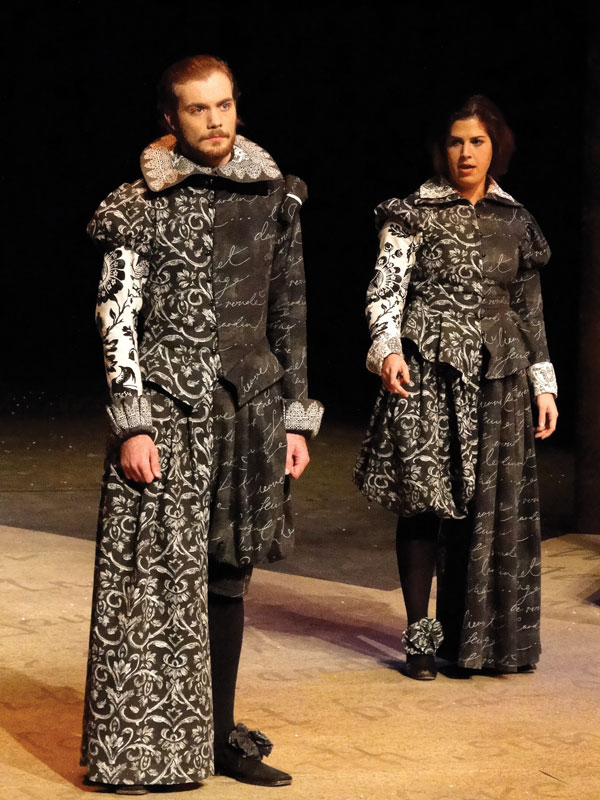From Moscow to Eugene, Then On to Beijing
UO costumes selected for an international exhibit will come home for “First Folio” gala.

These well-traveled costumes have made an international splash, having been selected for competitive theater design exhibits in Cardiff, Prague and now Moscow. They will be shipped back to Eugene for a few days for the First Folio event, then back to Moscow. Their next stop: Beijing.
The costumes were designed for “Love Will Shake,” an 2012 University of Oregon production adapted from Shakespeare’s sonnets and plays by Theatre Arts department head John Schmor, who also directed.
 In the play, Shakespeare is the main character, but divided into two separate characters: two lonely poets looking for love, William M. (male) and William W. (female), both vaguely cross-dressed (pictured at right). The upper body of their costumes is identical and androgynous; the lower body of each is costumed in a split fashion: half skirt/half gallaskins (breeches).
In the play, Shakespeare is the main character, but divided into two separate characters: two lonely poets looking for love, William M. (male) and William W. (female), both vaguely cross-dressed (pictured at right). The upper body of their costumes is identical and androgynous; the lower body of each is costumed in a split fashion: half skirt/half gallaskins (breeches).
This doubling and gender ambiguity is amplified by another character, Queen Elizabeth, who identifies with them, “You have made a division of yourself? Queer. But I see the use. I am my own double—a virgin prince.”
The half skirt/half breeches idea began as a sketch by costume designer Bonds to illustrate the concept of the split personae in the narrative. The original sketch was to offer either breeches or a skirt for the female Shakespeare but Schmor, as director, didn’t didn’t see it that way. He wanted both, to signal the division of the character.
At first, Bonds didn’t think this was a very compelling or original idea, but she went with the director’s choice and not only did it work well for the production, it also brought worldwide attention and acclaim to the costuming for the show overall.
A total of 22 costumes were designed for the ensemble cast. Another innovative aspect of the design was the printing of text—specifically text from the letters of Queen Elizabeth—on the fabric of many of the costumes.

She did the same with lace, consulting a book of lace from the Victoria and Albert Museum, scanned the 16th century examples, and sent it to the custom printer, where the images were printed onto fabric from which the costumes were made by the students working in the costume shop.
For her creative efforts on “Love Will Shake,” Bonds has received what she calls “the triple crown”—her work was selected for the top three exhibits in theater design in the world.
In 2013, “Love Will Shake” was among 120 worldwide productions selected for costuming for the World Stage Design exhibition in Cardiff, which features “the most innovative and ground breaking designs for performance from across the world.” For this exhibit the William W and William M costumes were flown to Cardiff to be exhibited.
In 2015, the production was selection for the Prague Quadrennial, which every four years presents theatre design from dozens of countries. For 2015, 56 countries were represented, and the US curators chose “Love Will Shake” as one of 18 productions to represent costuming. Queen Elizabeth’s wig and ruff were exhibited at the Prague Quadrennial.
Also in 2015, the production was selected in an international competition called “Costume at the Turn of the Century 1990-2015” at the A.A. Bakhrushin Central State Theatre Museum in Moscow. 31 countries entered more than 300 designers; Bonds was one of the US curators—and she submitted her work separately, as the curators were invited to do. The event organizers in Moscow then did the final curation and selected “Love Will Shake for exhibition. The William W and William M costumes are currently on exhibit there.

Alexandra Bonds in Moscow, where her costumes from “Love Will Shake” were exhibited in the “Costume at the Turn of the Century 1990-2015” design competition.
The William W and William M costumes will be flown to Eugene on January 3 for the “First Folio” gala on January 9, where they will be worn by two current Theatre Arts students. The costumes will then be flown back to Moscow, and then go on to Beijing next summer when the entire “Costume at the Turn of the Century 1990-2015” travels to China.
The happy accident of sketching a concept that ultimately proved worthy of international acclaim parallels Bonds’ own happy accident of getting into costume design. She started out, like many who are drawn to theater, wanting to act—having first been intrigued by a production of “Carousel” she saw as a child. But once she had the opportunity to appear on stage, she decided that acting was not for her. She then gravitated toward set design, but at the time, there was room for only one graduate student in that department, so she was assigned to the costume shop. And she loved it so much that, when she was invited to join the set design crew, she stayed in costuming.
The accolades for her work on “Love Will Shake” crown a 36-year career with the UO. Bonds retired in June and is imagining what comes next for an encore.


 Twitter
Twitter Facebook
Facebook Forward
Forward